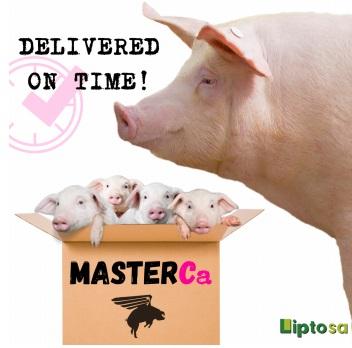
Content sponsored by:
LIPTOSA
Common Problems in Breeding Sows
Published: July 7, 2021
By: Arança Castellón, National Technical Sales Manager

COMMON PROBLEMS IN BREEDING SOWS
The high prolificacy of modern genetic lines provides extraordinary productivity, but at the same time increases the frequency of problems which, if not managed properly, will increase the culling rate. Among the main challenges we can mention:
Mastitis-metritis-agalactia (MMA)
When piglet deliveries take too long, adrenaline is secreted, and it counteracts oxytocin’s effects (an hormone responsible for the contraction of the uterine myometrium during birth and key to release colostrum to the mammary glands for feeding the piglets). Likewise, in these complicated deliveries, not all the content is normally expelled (fetal remains, placenta...) and manual interventions are required, which may cause injuries to the epithelium and mucosa of the uterus and / or vagina. All this leads to the appearance of the MMA syndrome.
In the case of subclinical processes, these tend to go unnoticed therefore economic consequences can be even more significant than clinical cases due to the large number of animals affected. Nevertheless, it is important to emphasize the importance of detected MMA animals because they are directly related to an increase in the mortality of affected sows and piglets, even if they are occasional.
Prolapses
In recent years, an increase in vaginal, uterine and rectal prolapses has been observed in sows, which are normally related to the moment of parturition.
This has raised concerns about its impact on animal welfare, but also about the losses it can cause to producers. The etiology is still unknown and is considered multifactorial, being the size of the litter, the body condition of the sow, the presence of mycotoxins in the feed, genetics, and nutrition, some of the possible causes. Nevertheless, despite the scarcity of data in pigs, hypocalcemia has been classified as a risk factor for prolapses occurrence.
Subclinical hypocalcemia in sows
Calcium is a fundamental nutrient which, altogether with phosphorus, constitute the most important minerals of the body. Both are involved in multiple biological functions and are the main components of the skeleton. During pregnancy and lactation, their demand is significantly increased. Its main destination are the fetuses (taking on special importance during the last week of pregnancy) but also milk production (which is very high in calcium to help on the ossification of the newborn piglets).

These requirements are usually covered through specific diet formulations, by increasing the feed intake or through physiological changes in the metabolism of calcium and phosphorus. However, an imbalance in any of these points could easily compromise the health and performance of the sows.
Fallen sow syndrome
The high mineral requirements around delivery and during lactation (especially calcium) can easily turn to high mobilization of the main reservoir: bone tissue. This process can lead into an osteodystrophy with possible bone fractures. Clinical observations include lameness, Difficulty walking, paraplegia, and a sitting dog like position. Dr. Lecay (2018) conducted a clinical investigation in animals with this disease and observed that 91.6% of the cases were related to serum hypocalcemia. For this reason, one of the recommendations to avoid the appearance of this syndrome consists in the supplementation of calcium in the ration.
MASTERCa
Liptosa works to guarantee a holistic approach of the most frequent metabolic and musculoskeletal problems of breeding sows during transition period.
Each single component in MasterCa is key for achieving its purpose. First, it provides a highly bioavailable source of calcium, which reduces the impact of hypocalcaemia at these critical times for sows (it is also useful against osteodystrophy associated with the mobilization of calcium from the bones). Secondly, the botanical compounds included in MasterCa help, in one side, in keeping the liver in optimal conditions, minimizing the incidence of ketosis in sows (a condition that leads to weight loss and a decrease in milk production), and in the other side, support the sows milk production, for a better piglet’s growth.
In the short term, MasterCa reduces both, delivery time and the need for manual intervention, increasing the number of live and vigorous births. In the long term, a reduction in the number of animals with lameness is observed, allowing less deviation in the farms, as well as optimizing the reproductive potential of the sow.
Notable results:
In order to quantify the benefits that MasterCa brings to the farms as accurately as possible, we are currently conducting multiple tests with MasterCa through different farms in Spain. Significant improvements have been observed in parameters such as:
1. Delivery time: 60 minutes reduction.
2. Piglet weaning weight: 147g higher
Those are only some of the most notable benefits of our MasterCa product. For more information, please contact us.
Related topics:
Authors:
LIPTOSA
Influencers who recommended :
Carlos López ToméRecommend
Comment
Share
17 de agosto de 2021
With refer to piglets lost in cases of subclinical metritis see the article:
"A novel method for the diagnosis of bacterial contamination in the anterior vagina of sows based on measurement of biogenic amines by ion mobility spectrometry :A field trial"
S. Marcus et' al. : Theriogenology 2012 sep. 1:78 (4) 753-8
Recommend
Reply

Would you like to discuss another topic? Create a new post to engage with experts in the community.

